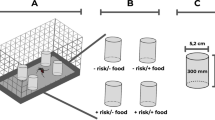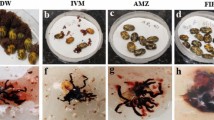Summary
The output of first stage larvae of the neurotrophic nematode Elaphostrongylus rangiferi was studied both in a herd of reindeer in the field and in reindeer held in captivity. There was a marked seasonal cycle in the output of larvae from infected reindeer. This seasonal cycle is dependent on host sex. After an initial phase of logarithmic increase from the onset of patency in late winter/spring, the larval output declines to a minimum in summer in both female and male reindeer. From then onwards a yearly cycle is repeated with a maximum density of larvae in autumn/early winter from male reindeer, and in late winter/spring from female reindeer. E. rangiferi has an adult longevity of several years in the reindeer, and it is probable that the seasonal cycle of parasite output is linked to seasonal changes in the degree of host stress.
Similar content being viewed by others
References
Anderson RC (1963) The incidence, development and experimental transmission of Pneumostrongylus tenuis Dougherty (Metastrongyloidea: Protostrongylidae) of the white-tailed deer (Odocoileus virginianus borealis) in Ontario. Can J Zool 41:775–792
Anderson RM, May RM (1982) Population biology of infectious diseases. Springer, Berlin Heidelberg New York
Bliss CI (1970) Statistics in biology, vol 2. McGraw-Hill Book Company, New York
Gaudernack G, Halvorsen O, Skorping A, Stokkan KA (1984) Humoral immunity and output of first stage larvae of Elaphostrongylus rangiferi (Nematoda, Metastrongyloidea) by infected reindeer, Rangifer tarandus tarandus. J Helminth 58:13–18
Gibbs HS (1973) Transmission of parasites with reference to the strongyles of domestic sheep and cattle. Can J Zool 51:281–289
Halvorsen O, Andersen J, Skorping A, Lorentzen G (1980) Infection in reindeer with the nematode Elaphostrongylus rangiferi Mitskevich in relation to climate and distribution of intermediate hosts. In: Reimers E, Gaare E, Skjenneberg S (eds) Proc 2nd Int Reindeer/Caribou Symp. DVF, Trondheim, pp 449–455
Halvorsen O, Anderson RM (1982) On the population biology of Elaphostrongylus rangiferi (Nematoda) in reindeer, Rangifer tarandus tarandus. Mol Biochem Parasitol (Suppl), pp 469–470
Halvorsen O, Skorping A (1982) The influence of temperature on growth and development of the nematode Elaphostrongylus rangiferi in the gastropods Arianta arbustorum and Euconulus fulvus. Oikos 38:285–290
Halvorsen O, Wissler K (1983) Methods for estimating the density of Elaphostrongylus rangiferi Mitskevich (Nematoda, Metastrongyloidea) larvae in faeces from reindeer, Rangifer tarandus L. Rangifer 3:33–39
Kummeneje K (1974) Encephalomyelitis and neuritis in acute cerebrospinal nematodiasis in reindeer calves. Nord Veterinaermed 26:456–8
Kutzer E, Prosl H (1975) Zur Kenntnis von Elaphostrongylus cervi Cameron 1931. 1. Morphologie und Diagnose. Wien Tierärztl Monatsschr 62:258–266
Lyubimov MP (1959) Sezonnaya dinamika elaphostrongilesa i setarioza patovykh olenei. Tr Gel'mintol Lab, Akad Nauk SSSR 9:155–156
Mitskevich V Yu (1960) Elaphostrongylus rangiferi n. sp. A new species of helminth from reindeer (In Russian). Tr Inst Zool Alma-Ata 12:115–119
Nettles VF, Prestwood AK (1976) Experimental Parelaphostrongylus andersoni infections in white-tailed deer. Vet Pathol 13:381–393
Nieminen M (1980) Nutritional and seasonal effects on the haematology and blood chemistry in reindeer (Rangifer tarandus tarandus L.). Comp Biochem Physiol A 66:399–413
Nieminen M, Kosela M, Leinonen M, Timisjarvi J (1980) Electrophoretical and immunoelectrophoretical studies on serum proteins in growing and fully-grown reindeer (Rangifer tarandus tarandus L.). Comp Biochem Physiol B 65:35–44
Platt TR, Samuel WM (1978) Parelaphostrongylus odocoilei: life cycle in experimentally infected cervids including the mule deer, Odocoileus h. hemionus. Expl Parasit 46:330–338
Prosl H, Kutzer E (1980) Zur Biologie und Bekämpfung von Elaphostrongylus cervi. Z Jagdwiss 26:198–207
Roneus O, Nordkvist M (1962) Cerebrospinal and muscular nematodiasis (Elaphostrongylus rangiferi) in Swedish reindeer. Acta Vet Scand 3:201–225
Ryan TA, Joiner BL, Ryan BF (1976) MINITAB. Student Handbook. Duxbury Press, Massachusetts
Yousef MK, Cameron RD, Luick JR (1971) Seasonal changes in hydrocortisone secretion rate of reindeer Rangifer tarandus. Comp Biochem Physiol A 40:495–501
Author information
Authors and Affiliations
Rights and permissions
About this article
Cite this article
Halvorsen, O., Skorping, A. & Hansen, K. Seasonal cycles in the output of first stage larvae of the nematode Elaphostrongylus rangiferi from reindeer, Rangifer tarandus tarandus . Polar Biol 5, 49–54 (1985). https://doi.org/10.1007/BF00446045
Received:
Accepted:
Issue Date:
DOI: https://doi.org/10.1007/BF00446045




